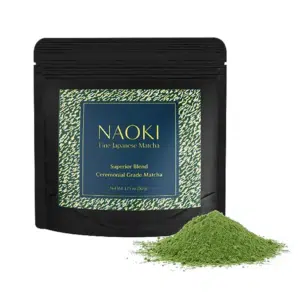Matcha is a powdered green tea made from the specially prepared whole leaves of the tea plant. Originating in China, it was later introduced to Japan where to this day it is an integral part of traditional Japanese tea ceremonies. In recent years matcha has gained popularity worldwide for its distinctive flavor and its potential health benefits.
Like all tea varieties (see our free download, An Intro to Tea), matcha starts with the Camellia sinensis plant. In order to give matcha its bright green color, the plants are grown in the shade to increase their chlorophyll production. The leaves are hand-picked in the early spring when they are still tender and steamed to prevent oxidation and to preserve their color and nutrients. They are then dried and deveined, resulting in a product known as tencha (a green tea). The tencha leaves are stone-ground into a fine, bright green powder to become matcha.
Matcha comes in different grades, which vary in flavor, color, and quality. The finest grade, “ceremonial grade,” is made from the youngest leaves and has a sweet, mellow flavor and a vibrant green color. Culinary-grade matcha is used in cooking, baking, and smoothies and has a slightly stronger flavor. Both varieties are grassy and vegetal with a slight bitter finish and a hint of sweetness.
Matcha has numerous health benefits and is purported to help with everything from regulating blood pressure and reducing the risk of cancer to weight loss and mental calm. It’s rich in antioxidants which may help protect cells from damage and improve cardiovascular health.1 Matcha is thought to boost metabolism and aid in weight management, including faster oxidation of fat during exercise.2 Like all tea it contains L-theanine which balances out caffeine and can promote relaxation and mental clarity. Studies have shown that matcha can increase alertness, decision- making ability, memory, and focus,3 as well as slow age-related cognitive decline.
In addition to traditional tea preparation, matcha is used in various culinary creations, including lattes, smoothies, ice cream, cakes, and other desserts. Its vibrant green color can add a unique visual appeal to dishes. Here we share a few ways to enjoy this versatile and uniquely flavored form of tea and its health benefits.
Recipes from this article:
Try it for yourself:

Sources:
1 Karolina Jakubczyk, Karolina, et al, “Antioxidant Properties and Nutritional Composition of Matcha Green Tea,” April 12, 2020
2 Cox, Hannah R. et al, “Green tea extract ingestion, fat oxidation, and glucose tolerance in healthy humans,” August 12, 2021
3 Dietz, Christina, et al, “Effect of Green Tea Phytochemicals on Mood and Cognition,” 2017 4 Nakamura, Yoriyuki, et al, “Green Tea Supresses Brain Aging,” July 19, 2021





